|
http://bstroop501.ScoutLander.com
|
|
|
|
|
|
 |
 |
 |
 |
|
 |
 |
 |
 |
|
|
 |
 |
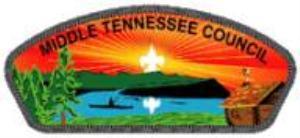
|

This Web site is for information about Boy Scout Troop 501 Dover, Tennessee.
We are a member of the Cogioba District which serves Houston,
Montgomery,Steward Counties and Fort Campbell, KY in the Western Service
Area of the Middle Tennessee Council.
We support the Anawaha Chapter of the Wa-Hi-Nasa 111 Lodge, Order Of The Arrow.
Our Troop is open to anyone to join. We are one of the oldest Boy Scout
Troops in the area. We are always in need of adult leaders, as well as
new or returning scouts. Please drop us a line a nd we will set you up
with a chance of a life time to help us grow.
Our Troop is chartered by The Dover Kawaiis . AND WE MEET EVERY TUESDAY AT THE OLD DOVER ELEMENTARY SCHOOL where theh 5th grade rooms were located at.
Our Scoutmaster is Max Touchton , his email address is emtee-501@hughes.net our Secretary Assisitant is Connie Milton and her email is miltonscfd@yahoo.com
If you are
interested in scouting in any area just come by and see us or contact
our Troop by email. For more information please contact the Scoutmaster Max Touchton at (931) 232-6639 or the Middle Tennessee
Council Boy Scouts of America located in Nashville,Tn by calling (615)
383-9724 or 1-800-899-7268.

For more information about Scouting in Middle Tennessee, please visit the website for the Middle Tennessee Council Boy Scouts of America at www.mtcbsa.org.
For general information about Scouting and the various programs, please visit the website for the national organization for the Boy Scouts of America at www.Scouting.org.
Our Website Disclaimer:
Troop 501 does not speak on behalf of the BSA nor our Charter Unit.
The opinions expressed on these web pages are those of the Scout
leaders of Troop 501. Logos, badges, insignias, and buttons are the
copyright and/or trademark of their respective owners.The things found
on these pages are intended for the use of Troop 501, The Charter
Unit and its families. Boy Scouts Of America Troop 501 is not
responsible for any misrepresentation or misinformation regarding the
BSA, Council or District organization. Troop 501 is not responsible for
any errors contained on this site. Please contact the Webmaster
regarding any corrections. This site if for your Scouting benefit.
Please Enjoy

|
|
 |
 |
|
 |
 |
 |
 |
 |
 |
 |
 |
|
 |
 |
 |
 |
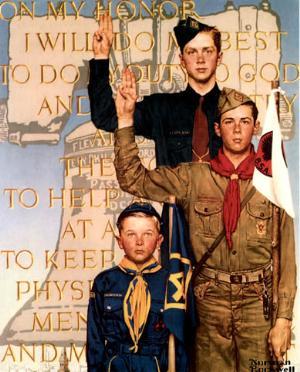
|
A scout is
Trustworty,
Loyal,
Helpful,
Friendly,
Courteous,
Kind,
Obedient,
Cheerful,
Thrifty,
Brave,
Clean,
and
Reverant
|
|
 |
 |
|
 |
 |
 |
 |
 |
 |
 |
 |
|
 |
 |
 |
 |

|
Be Prepared!
In various languages, it has been used by millions of Scouts around the world since 1907.
Of
course, it is no coincidence that this motto can be shortened to B. P.
and Robert Baden-Powell, the founder of the movement, used to shorten
his surname into B.-P.
In the third part of Scouting for Boys dated February 12, 1908, Robert Baden-Powell explains the meaning of the phrase:
The Scout Motto is: BE PREPARED which means you are always in a state of readiness in mind and body to do your DUTY.
- Be Prepared in Mind
by having disciplined yourself to be obedient to every order, and also
by having thought out beforehand any accident or situation that might
occur, so that you know the right thing to do at the right moment, and
are willing to do it.
- Be Prepared in Body by making yourself strong and active and able to do the right thing at the right moment, and do it.
|
|
 |
 |
|
 |
 |
 |
 |
 |
 |
 |
 |
|
 |
 |
 |
 |
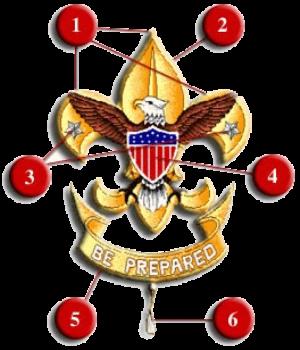
|
- The three points of the trefoil stand for the three parts of the Scout Oath.
- The shape of the Scout badge means that a Scout can point the right way in life as truly as does a compass in the field.
- There are two stars on the badge. They symbolize truth and knowledge.
- The eagle and shield stand for freedom and a Scout's readiness to defend that freedom.
- The scroll bearing the Scout motto is turned up at the ends as a reminder that a Scout smiles as he does his duty.
- The knot at the bottom of the scroll serves as a reminder of the Scout slogan, Do a Good Turn Daily.
|
|
 |
 |
|
 |
 |
 |
 |
 |
 |
 |
 |
|
 |
 |
 |
 |

|
The Outdoor Code
As an American, I will do my best to -
- Be clean in my outdoor manners.
I will treat the outdoors as a heritage.
I will take care of it for myself and others
I will keep my trash and garbage out of lakes, streams, fields, woods, and roadways.
- Be careful with fire.
I will prevent wildfire.
I will build my fires only where they are appropriate.
When I have finished using a fire, I will make sure it is cold out.
I will leave a clean fire ring, or remove all evidence of my fire.
- Be considerate in the outdoors.
I will treat public and private property with respect.
I will use low-impact methods of hiking and camping.
and
- Be conservation minded
I will learn how to practice good conservation of soil, waters, forests, minerals, grasslands, wildlife, and energy.
I will urge others to do the same.
|
|
 |
 |
|
 |
 |
 |
 |
 |
 |
 |
 |
|
 |
 |
 |
 |
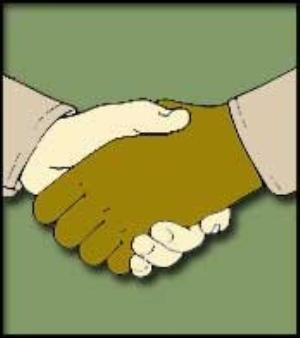
|
Our
Scout salute and handshake are ancient signs of bravery and respect.
During the colonial period of our country, many men carried weapons for
protection.
Sometimes
when they met one another, there was an uneasy moment as each man
watched the others right hand. If it went to his sword or his gun, there
might be a fight. but if it went to his hat, it was a salute of
friendship and respect.
The
left handshake comes to us from the Ashanti warriors whom Lord
Baden-Powell, the founder of Scouting, knew almost 100 years ago in West
Africa. He saluted them with his right hand, but the Ashanti chiefs
offered their left hands and said, "In our land only the bravest of the
brave shake hands with the left hand, because to do so we must drop our
shields and our protection."
The
Ashantis knew of Baden-Powell's bravery because they had fought against
him and with him, and they were proud to offer the left hand of
bravery.
When you use the Scout salute and handshake, remember that they are signs of respect and courage.
The left hand is also closer to the heart...
|
|
 |
 |
|
 |
 |
 |
 |
 |
 |
 |
 |
|
 |
 |
 |
 |
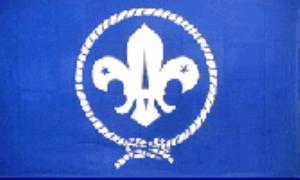
|
In
Scouting's early years, critics accused Baden-Powell of trying to turn
boys into soldiers, holding up as evidence the Scout symbol, which they
called "a spear-head, the emblem of battle and bloodshed". The Founder
quickly replied, The crest is the "Fleur-de-Lis", a lily, the emblem of
peace and purity.
In
truth, he had chosen as Scouting's emblem the sign for the North Point,
universally shown on maps, charts and compass cards, because "it points
in the right direction (and upwards), turning neither to the right nor
left, since these lead backward again..." Lady Baden-Powell added later,
"It shows the true way to go."
Baden-Powell
explained the origins of this sign. In the Middle Ages, mariner Flavio
Gioja designed it to make the seaman's compass more reliable. In
Italian, North was "Tramontana". Gioja used a capital "T" to mark it,
and in deference to King Charles of Naples, whose crest was the
Fleur-de-Lis, combined the letter with that emblem.
To
explain the meaning of the Scout emblem, Baden-Powell said, "The two
stars on the two side arms stand for the two eyes of the Wolf Cub having
been opened before he became a Scout... The three points of the
Fleur-de-Lis remind the Scout of the three points of the Scout's
Promise..."
In
the World Scout emblem, the Fleur-de-Lis is surrounded by a circle of
rope tied with a reef knot to symbolize the strength and unity of the
world brotherhood of Scouting: "Even as one cannot undo a reef knot, no
matter how hard one pulls on it, so as it expands, the movement remains
united."
The
three tips of the Fleur-de-Lis represent the three main parts of the
Scout promise: duty to God, obedience to the Scout Law, and service to
others. The two five-point stars stand for truth and knowledge, and the
10 points on the stars remind us of the 10 points of the Scout law. The
ring holding the emblem together represents the bond of brotherhood.
The
symbol is white on a royal purple background, colors Baden-Powell chose
because, in heraldry, white stands for purity and purple for leadership
and helping others.
Since
Scouting began, over 200 million Scouts have worn the Scout symbol,
making it one of the more highly recognized emblems in the world. Today,
over 150 World Scouting countries and territories, more than 16 million
members continue to wear it with pride.
|
|
 |
 |
|
 |
 |
 |
 |
|
|
|
|
|
|
|
|
 |
 |
|
|
|
|
 |
 |
|
 |
 |
 |
 |
|
|
|
|